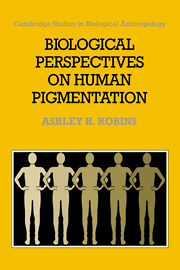Book contents
- Frontmatter
- Contents
- Dedication
- Preface
- Acknowledgements
- 1 Biology of the pigment cell
- 2 The biochemical and hormonal control of pigmentation
- 3 Ultraviolet radiation and the pigmentary system
- 4 Functions of melanin
- 5 Non-cutaneous melanin: distribution, nature and relationship to skin melanin
- 6 The properties and possible functions of non-cutaneous melanin
- 7 Measurement of skin colour
- 8 Disorders of hyperpigmentation
- 9 Disorders of hypopigmentation
- 10 Skin colour and society: the social–biological interface
- 11 The evolution of skin colour
- References
- Index
6 - The properties and possible functions of non-cutaneous melanin
Published online by Cambridge University Press: 02 December 2009
- Frontmatter
- Contents
- Dedication
- Preface
- Acknowledgements
- 1 Biology of the pigment cell
- 2 The biochemical and hormonal control of pigmentation
- 3 Ultraviolet radiation and the pigmentary system
- 4 Functions of melanin
- 5 Non-cutaneous melanin: distribution, nature and relationship to skin melanin
- 6 The properties and possible functions of non-cutaneous melanin
- 7 Measurement of skin colour
- 8 Disorders of hyperpigmentation
- 9 Disorders of hypopigmentation
- 10 Skin colour and society: the social–biological interface
- 11 The evolution of skin colour
- References
- Index
Summary
The circulation of melanin
The melanosomes in epidermal melanocytes are transferred to keratino cytes, thereafter conveyed upwards to the stratum corneum, and eventually disposed of by desquamation. There is also a less well-known transaction that proceeds in the opposite direction: a circulation of melanin from the skin to the internal organs of the body.
The knowledge that melanin is manufactured in the skin by in situ pigment cells dates from relatively recent times. The early nineteenthcentury notion was that black pigment originated in the bile, and ingenious theories were devised of how bile turned itself into the colouring material of the skin. In an informative review of the literature, Wassermann (1965a) showed that the circulation of pigment was actually the first aspect to be described. A hundred years ago it was thought that wandering cells, probably leucocytes (white blood corpuscles), scavenged red blood cells and carried them and their pigment (haemoglobin) to the epidermis for its nutrition, the haemoglobin then being transformed into melanin. Even though these ideas may now seem preposterous, the concept of a circulation of melanin has recently been revived and revised.
The dermis contains an extensive network of lymphatic ducts which drain into lymph nodes. There is a much higher incidence of melanin deposition in the skin-draining lymph nodes of Negroids than of Caucasoids (Wassermann, 1965a). This suggests that melanin is transported by lymphatic drainage into the circulation from which it can then be distributed throughout the body.
The modern approach to the circulation of melanin stems chiefly from the work of Wassermann (1974). He used the skin-window technique to show the inflammatory response in the skin of South African Negroid and ‘Cape Coloured’ subjects.
- Type
- Chapter
- Information
- Biological Perspectives on Human Pigmentation , pp. 88 - 97Publisher: Cambridge University PressPrint publication year: 1991



